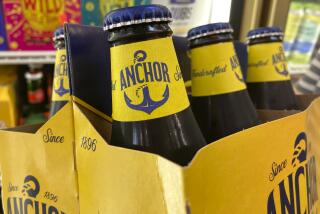Two Anchors Are Better Than One
The Skipper Says: They put down their anchor near you, barely leaving room in their swinging radius, and when they start to drag into you, they seem surprised. âIâve got 200 feet of chain out,â they say. So what! Their anchorâs down in 80 feet of water, a little over two-to-one scope, and, whatâs more, they just dropped the hook down and didnât set it properly. They think because theyâve got chain, that solves everything. I see it all the time.
--Charles Cahill, commercial abalone diver, who, with his wife Rita, live on their boat off Catalina Island.
Nearly everybody who has anchored in Catalinaâs coves this crowded summer has experienced problems similar to Cahillâs. In a recent attempt to make his anchored position more secure and to limit his radius of swing, Cahill set down two anchors--one off his bow, the other off his stern, each with about four-to-one scope.
Positioning his boat in between the two, he brought the rode of his stern anchor forward and belayed it on his bow cleat. Thus, no matter which way the wind blew, he always had one anchor holding him.
This so-called Bermuda or Ogg system of double anchoring is excellent. The trouble with it (and Cahill had this trouble) is that other skippers, unfamiliar with the system, are confused by the sight of two rodes angling off the bow chock, or they donât pay attention to it. In either case, they are likely to foul the anchor off your stern by putting down their anchor over it. One solution is to stream a light line from your rodes with a red surface float attached.
The problem of swinging on a bow anchor alone is that a change in wind direction can upset the anchor and cause the vessel to drift. The conventional plow or Danforth anchor usually resets itself within about 15 feet, but, as any experienced skipper knows, itâs always prudent to check the anchor after a wind change.
Some, like Cahill and myself, use rope as our rodes. The rope is shackled to about 25 feet of chain above the anchor. The weight of the chain helps keep the flukes of the anchor dug into the bottom. A few good tugs on the rope rode assures us that our hook is dug in and holding. Should we feel vibrations on the rode, we know our hook is not holding and take means to correct it. Usually some more determined tugs on the rode will reset it. However, if this fails, the anchor may be dragging on kelp. Then we must haul anchor and re-anchor. When this happens in the middle of the night, itâs an unwelcome exercise. Thatâs why many prefer paying for a mooring when one is available.
However, this time of year, from Avalon through the coves at Whiteâs and to the Isthmus area, mooring cans are usually not available over crowded weekends. So, until after Labor Day, a skipper arriving at Catalina on a Saturday must face the possibility of anchoring his vessel.
You should be forewarned that the shallower anchoring areas will be taken up first. In this case you should be prepared to anchor in 80 to 120 feet of water. Many yachts arrive at Catalina ill-prepared for this eventuality. They have only 150 feet of anchor rope in their lockers or coils. This is barely enough. I carry 350 feet of rope rode in my 27-foot Herald Birdâs locker, plus an extra 150 feet in a coil that I can bend on if I have to. This arrangement, Iâve found, is adequate. I carry two 20-pound Danforth anchors. My stern anchor has 200 feet of rode attached to it.
One of the best investments Iâve made is in a little hand-operated windlass mounted on my foredeck. It takes both rope and chain. If I hadnât had that windlass a weekend ago off the beach at Whiteâs Landing, I would have been forced to lose a couple of hundred dollarâs worth of ground tackle.
I pump on the steel handle and my wife tails this windlass. Itâs a great labor and back-saver. When it came to haul anchor, I discovered there was great weight on it. Without the windlass, I would have been unable to bring up my anchor.
It turns out that I had been laboring to lift an estimated 100-pound iron cart, resembling a wheel barrow, that had fouled my rode. A helpful harbor patrolman untangled the cart when I got it to the surface. It sank into the deeps again. Presumably the cart was from the mining operation at Whiteâs Landing in the 1920s.
Under D. M. Renton, William Wrigleyâs general manager, mining operations were started at Mt. Black Jack, which rises behind Whiteâs. Galena, lead and zinc-bearing ore were mined and carried by aerial cable across canyons to the beach at Whiteâs, where the Balboa Yacht Club now maintains a shore facility.
If any historical mining buff wishes to recover that old cart, itâs in about 100 feet of water about 1,000 yards off the BYC shore base. Simply anchor there, and you may be lucky. As for me, Iâm avoiding that spot.
More to Read
Sign up for The Wild
Weâll help you find the best places to hike, bike and run, as well as the perfect silent spots for meditation and yoga.
You may occasionally receive promotional content from the Los Angeles Times.






